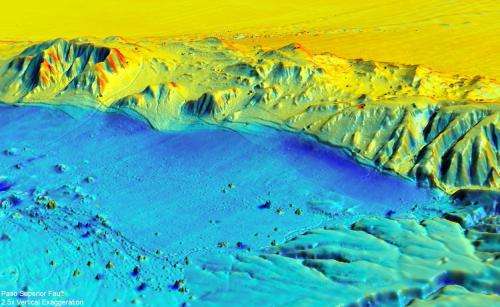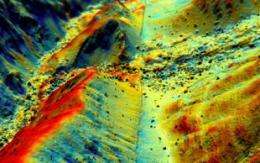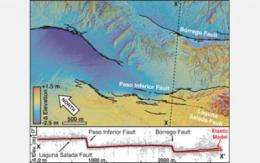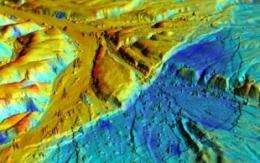Researchers create 3-D laser maps that show how earthquake changes landscape

Geologists have a new tool to study how earthquakes change the landscape down to a few inches, and it's giving them insight into how earthquake faults behave. In the Feb. 10 issue of the journal Science, a team of scientists from the U.S., Mexico and China reports the most comprehensive before-and-after picture yet of an earthquake zone, using data from the magnitude 7.2 event that struck near Mexicali, northern Mexico in April, 2010.
"We can learn so much about how earthquakes work by studying fresh fault ruptures," said Michael Oskin, geology professor at the University of California, Davis and lead author on the paper.
The team, working with the National Center for Airborne Laser Mapping (NCALM), flew over the area with LiDAR (light detection and ranging), which bounces a stream of laser pulses off the ground. New airborne LiDAR equipment can measure surface features to within a few inches. The researchers were able to make a detailed scan over about 140 square miles in less than three days, Oskin said.
Oskin said that they knew the area had been mapped with LiDAR in 2006 by the Mexican government. When the earthquake occurred, Oskin and Ramon Arrowsmith at Arizona State University applied for and got funding from the National Science Foundation to carry out an immediate aerial survey to compare the results.

Coauthors John Fletcher and graduate student Orlando Teran from the Centro de Investigación Científica y de Educación Superior de Ensenada (CICESE) carried out a traditional ground survey of the fault rupture, which helped guide planning of the aerial LiDAR survey and the interpretation of the results.
From the ground, features like the five-foot escarpment created when part of a hillside abruptly moved up and sideways are readily visible. But the LiDAR survey further reveals warping of the ground surface adjacent to faults that previously could not easily be detected, Oskin said. For example, it revealed the folding above the Indiviso fault running beneath agricultural fields in the floodplain of the Colorado River.
"This would be very hard to see in the field," Oskin said.

Team members used the "virtual reality" facility at UC Davis's W. M. Keck Center for Active Visualization in Earth Sciences to handle and view the data from the survey. By comparing pre- and post-earthquake surveys, they could see exactly where the ground moved and by how much.
The survey revealed deformation around the system of small faults that caused the earthquake, and allowed measurements that provide clues to understanding how these multi-fault earthquakes occur.
The 2010 Mexicali earthquake did not occur on a major fault, like the San Andreas, but ran through a series of smaller faults in the Earth's crust. These minor faults are common around major faults but are "underappreciated," Oskin said.
"This sort of earthquake happens out of the blue," he said.

The new LiDAR survey shows how seven of these small faults came together to cause a major earthquake, Oskin said.
Ken Hudnut, a geophysicist with the U.S. Geological Survey and coauthor on the paper, made the first use of airborne LiDAR about 10 years ago to document surface faulting from the Hector Mine earthquake. But "pre-earthquake" data were lacking. Since then, NCALM has carried out LiDAR scans of the San Andreas system (the "B4 Project") and other active faults in the western U.S. (a component of the EarthScope Project), thereby setting a trap for future earthquakes, he said.
"In this case, fortunately, our CICESE colleagues had set such a trap, and this earthquake fell right into it and became the first ever to be imaged by "before" and "after'" LiDAR. It is a thrill for me to be on the team that reached this important milestone," Hudnut said.
More information: The post-event dataset collected by the team is publicly available through www.opentopography.org
Provided by University of California - Davis




















